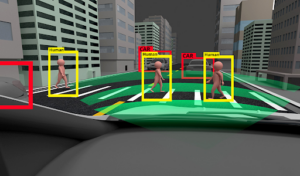Today, our world witnesses technology that helps us bridge gaps between concrete and digital things. Enter augmented reality: A technology fast impacting so many industries and organizations through its use of analytics and big data superimposed on the real world.
“Most people do not recognize that they use AR already– AR works in photography apps, filters, and other real-time games. ”
In business-to-business settings, applications abound; an example is the navigation display, now part of car models.
In this article, we detail more factors and reasons how AR helps businesses to grow. Its role in delivering information, structuring data, and managing companies should take centre stage in the years to come.
Augmented Reality: How It Helps Businesses
Augmented reality, according to Harvard Business Review, “allows people to process the physical and digital simultaneously, eliminating the need to bridge the two mentally.”
It does more when applied to business applications because it intertwines digital information with the actual physical material advertised to consumers.
How does this work? In contrast, engineers had to work with complex 2-D blueprints to secure steel construction structures for a ship in the past.
With AR, final designs can already be superimposed on the carrier vehicle, even reducing actual inspection time from more than 30 hours to 90 minutes.
Imagine the impact it brings not just to shipbuilding but to an entire plethora of fields. AR will help significantly in increasing productivity in manufacturing as an example.
Consumers Can Now Try Products Before Buying Them
In the cosmetics and skincare industry, AR apps allow customers to view how they might look given the purchase of select makeup products. This AR application is an excellent way to market various products and services.
There are also existing retail apps in interior design that lets customers design their homes given the selection of furniture on sale.
AR in this context provides opportunities for personalization and customization, but it also engages loyal and prospective clients alike. The same example exists in various clothing stores, too.
AR for Solution-Oriented Products and Services
Businesses that use their solutions and with their design teams also use AR. For example, a water company used smart glasses on a mobile app to render repair services.
These AR solutions drive more companies, experts, and vendors to share their expertise, even on a remote basis. With the help of AR technology, business owners can already manage even matters like safety better.
AR enables live support among many technicians and remote staff in terms of workforce management. These services also reduce a lot of manual work and introduce more streamlined, improved processes – making business operations smoother.
Additionally, isn’t it exciting that there might be no more need for bulky materials like complex instructions and manuals with the way AR transforms these solutions and collaborations? The applications alone can already do that for both the businesses and their partners.
The Use of AR Application in the Education Sphere
Companies that capitalize on human resources and training provisions also benefit from AR. For example, anatomy programs are already for medical students, taught using 3D holographic.
Innovations like this in training save time, effort, and resources. Employment development programs also use AR nowadays, giving them better learning experiences than traditional textbooks, flashcards, and lectures.
Additionally, companies may opt to hire a consultant to develop AR applications specifically for employee onboarding. Such moves will help boost workplace operations, promote employee welfare, and be a cost-cutting method.
AR Helps Create Customer-Centric Experiences
Another practical application of AR is to create various experiences for customers. Beyond just trying out makeup, clothing, or furniture, AR helps users enjoy meaningful experiences with services and products.
Businesses must use this feature to leverage how they use platforms like social media to continue to offer unique experiences (e.g., interacting with dragons while deciding on hairstyles).
AR as Business and Marketing Strategy
Other than the aforementioned examples of augmented reality in action, AR marketing helps businesses as a matter of strategy.
Storytelling in action, done by big names in the writing industry, also uses AR to attract more readership; this is why digital and online work is now available.
Businesses now also use VR apps for marketing purposes. Through AR, companies can now execute Know-Your-Customer (KYC) initiatives and other ways of promoting services, products, and overall branding; reinventing products is a top trend in marketing approaches.
Beyond that, companies can do an organizational overhaul with AR. All cost-reduction efforts, strategic positioning, and review of operational efficiencies can all improve. AR as a strategy also redefines the value chain of a business and addresses existing gaps in its workflow.
Therefore, with AR as both a marketing and operational strategy, companies can boost existing strengths and develop ways to customize their products and services.
The Bottom Line
With a billion smartphone users today, the world is really for the taking for companies from various fields. By consulting AR professionals, businesses can now jumpstart collaborative projects to transcend sales and transform lives.
An excellent way to look at AR is the catchphrase, “You have to try this!” With AR, something is always new – an experience or a product.
Use this to leverage your business. It is no wonder that companies have now started to see the value of digital modelling capabilities, for one, as part of the skill set some of their workforce and teams must-have.
Augmented reality is here to stay because it helps businesses and real people with real needs. It is convenient, fast, and revolutionary in many ways, and its power and potential, entrepreneurs must harness.
A word of advice to businesses: Watch out for how your company grows with AR integration over time.
Invest as early as now in scouting talent with skills in AR development, like user interface and user experience (UI/UX) designs – these are all critical already in this day of digital information dissemination. You won’t regret it.
Also, Read Why Businesses Need AR Strategy
- AI
- ai art
- ai art generator
- ai robot
- AIIOT Technology
- AR/VR
- artificial intelligence
- artificial intelligence certification
- artificial intelligence in banking
- artificial intelligence robot
- artificial intelligence robots
- artificial intelligence software
- blockchain
- blockchain conference ai
- coingenius
- conversational artificial intelligence
- crypto conference ai
- dall-e
- deep learning
- google ai
- machine learning
- plato
- plato ai
- Plato Data Intelligence
- Plato Game
- PlatoData
- platogaming
- scale ai
- Technology
- zephyrnet













